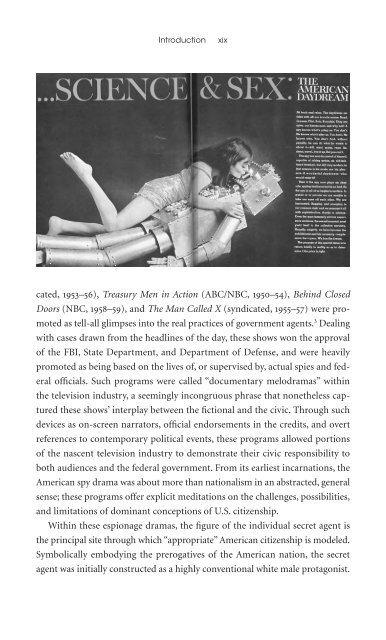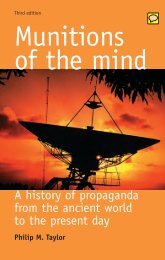Citizen-Spy
Citizen-Spy
Citizen-Spy
You also want an ePaper? Increase the reach of your titles
YUMPU automatically turns print PDFs into web optimized ePapers that Google loves.
x Preface<br />
doesn’t offer easily isolable, discrete objects of study. Does one study a particular<br />
program, an episode, a network, a studio, an advertising agency, an audience,<br />
a star? The methods of textual analysis that film scholars adapted from<br />
literary criticism don’t quite fit newer media. Whereas a given film might be<br />
studied as a relatively bounded narrative, television is complicated by episodic<br />
seriality and what Raymond Williams described as flow: an ongoing stream of<br />
information, in which individual programs, commercial messages, news, and<br />
public service announcements collide and combine. 1 And not only is television<br />
broadly intertextual, its texts are impermanent. While the historical significance<br />
of the most popular programs is disproportionately magnified by being preserved<br />
in the electronic amber of cable network syndication, countless important<br />
broadcasts now survive only as written transcripts or as residues in other<br />
historical accounts. Similarly, the supporting materials (scripts, production<br />
notes, correspondence, and so on) that offer insights into the circumstances of<br />
production are often discarded. This is in part due to the fact that television<br />
generates a vast amount of material, but it is also a product of the general low<br />
esteem in which this medium is often held—both by audiences and producers.<br />
Ironically, because television is seemingly “everywhere,” much that is important<br />
about it is at risk of disappearing from the historical record.<br />
But just as television is ephemeral, so too is the past. Ultimately unknowable,<br />
a foreign country, the past lingers out of sight, conjured only in the histories we<br />
write. 2 Hayden White suggests that the common assumption that crucial explanatory<br />
facts lie dormant—in the archive, in memories, in some endless public<br />
record—like little nuggets eager to be found (a-ha!) is a beguiling fallacy. We’d<br />
like to think that history is a sage process of first gathering data, then stringing<br />
it together in the most natural, coherent way—as if filling in the pieces of a precut<br />
jigsaw puzzle, 500 or 1000 to a box. White insists that narrative comes first;<br />
facts only become visible when placed in a covering framework within which<br />
they are rendered factual. 3 That’s not to say that history is arbitrary, but a host<br />
of assumptions—in the case of this book, about the development of the television<br />
industry, its place within a national and/or global culture, its relationships<br />
to other media artifacts and practices, and so on—lead toward certain<br />
kinds of facts and away from others. Furthermore, it is not only the historian’s<br />
narrative frameworks that shape this process; unspoken assumptions also guide<br />
those who (whether at the studio, the network, or the archive) had to select what



